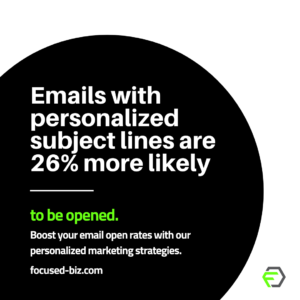Understanding the Impact of Personalization on Email Marketing
The Power of Personalization
How do you boost your email open rates? Easy. Personalization. In email marketing, this refers to the practice of tailoring the content of an email to individual subscribers based on their unique characteristics, preferences, and behaviors. By incorporating personalization into your email marketing strategy, you can significantly enhance engagement and drive higher open rates.
Understanding the Impact of Personalization on Email Marketing
The Power of Personalization
Personalization in email marketing refers to the practice of tailoring the content of an email to individual subscribers based on their unique characteristics, preferences, and behaviors. By incorporating personalization into your email marketing strategy, you can significantly enhance engagement and drive higher open rates.
Increased Relevance and Engagement
One of the main advantages of personalization is the ability to deliver relevant content to individual recipients. By using data such as their name, location, purchase history, or browsing behavior, you can create highly targeted emails that directly address their specific needs and interests. This level of customization makes subscribers feel valued and understood, leading to increased engagement and a higher likelihood of them opening and interacting with your emails.
Research has shown that personalized subject lines can improve open rates by 26%, highlighting the impact that even a simple personal touch can have on recipients. When emails are tailored to the recipient’s preferences or past interactions, it creates a sense of exclusivity and importance, making them more likely to open and engage with the content.
Building Trust and Loyalty
Personalization also helps build trust and loyalty with your audience. When subscribers receive emails that acknowledge their individuality and provide relevant content, they are more likely to view your brand in a positive light. By consistently delivering valuable and personalized messages, you develop a stronger relationship with your subscribers, fostering trust and loyalty over time.
Additionally, personalization allows you to segment your email list based on different criteria. This enables you to send targeted campaigns to specific segments, ensuring that subscribers only receive content that is most relevant to them. This level of tailored messaging not only enhances the user experience but also establishes your brand as one that truly understands its customers.
In conclusion, personalization is a powerful tool in email marketing that can significantly improve open rates and engagement. By utilizing the wealth of data available to you, you can create personalized subject lines and content that resonates with your subscribers, resulting in stronger relationships and increased conversions.

The Science Behind Email Subject Lines and Open Rates
The Importance of Email Subject Lines
The email subject line is the first thing that recipients see when an email lands in their inbox. It plays a crucial role in grabbing their attention and enticing them to open the email. Studies have shown that 47% of email recipients decide whether to open an email based solely on the subject line. Therefore, crafting compelling and personalized subject lines is essential for increasing email open rates.
The Power of Personalization
Personalizing email subject lines has proven to be highly effective in increasing open rates. When recipients see their name or other personalized details in the subject line, they are more likely to engage with the email. Research has shown that personalized subject lines can increase open rates by up to 26%. By addressing recipients by name or tailoring the subject line to their interests, you can create a sense of familiarity and relevance, making them more likely to click and open your email.
The Science behind Open Rates
Several factors contribute to the success of email subject lines in capturing recipients’ attention and boosting open rates. Firstly, the length of the subject line is crucial. Studies have found that shorter subject lines tend to perform better, as they are concise and less likely to get cut off in mobile devices or email previews. Aim for subject lines of around 50 characters or less to increase the chances of your email being opened.
Additionally, using action-oriented language and creating a sense of urgency can also improve open rates. By including strong action verbs or time-sensitive words, you can create a sense of importance and encourage recipients to open the email immediately. However, it’s important to avoid misleading or overly exaggerated subject lines, as this can harm your brand reputation and lead to lower engagement in the long run.
Furthermore, testing and analyzing the performance of different subject lines is key to optimizing open rates. A/B testing can help you determine which subject lines resonate best with your audience. Test variations in personalization, wording, and length to identify the most effective strategies for your specific target market.
In conclusion, understanding the science behind email subject lines and their impact on open rates is crucial for boosting the success of your email campaigns. By personalizing subject lines, keeping them concise yet impactful, and testing various approaches, you can significantly increase your email open rates and improve overall engagement with your audience.
Key Strategies to Implement Personalization in Subject Lines
Segment Your Audience
One key strategy to implement personalization in subject lines is to segment your audience. By dividing your email list into smaller, more targeted groups based on factors such as demographics, interests, or past behavior, you can tailor your subject lines to resonate with each specific segment. Personalizing subject lines based on the recipient’s unique characteristics and preferences will increase the likelihood of them opening your emails.
Use Dynamic Insertion Tags
Dynamic insertion tags are placeholders that allow you to automatically insert personalized information into your subject lines. By using these tags, you can include the recipient’s name, location, or any other relevant details in your subject line. This creates a sense of individualization and makes the recipient feel more valued. However, it’s important to ensure that the data you’re using is accurate and up to date to avoid any potential mistakes or inconsistencies.
Create a Sense of Urgency or Exclusivity
Another effective strategy to implement personalization in subject lines is to create a sense of urgency or exclusivity. By using phrases like “Limited time offer” or “Exclusive for you”, you can make your recipients feel that they have a special opportunity or a deadline to take advantage of. This can pique their curiosity and motivate them to open your email to find out more. However, be sure to use these tactics sparingly and genuinely, as overusing them can lead to a decrease in credibility and trust.

Measuring Success: Tracking and Analyzing the Results
Tracking Email Open Rates
To measure the success of your personalized subject lines in boosting email open rates, it’s vital to track and analyze the results. Tracking email open rates allows you to see how many recipients actually open your emails and engage with your content. This metric is a key indicator of the effectiveness of your subject lines and overall email marketing strategy.
Most email marketing platforms provide built-in tracking tools that allow you to monitor open rates. These tools generate data that can give you valuable insights into the performance of your personalized subject lines. By analyzing this data, you can determine if the changes you made to your subject lines had a positive impact on open rates.
Analyzing Open Rate Trends
Once you have tracked your email open rates, it’s important to analyze the trends over time. Look for patterns or fluctuations in open rates to identify any correlations between your subject lines and recipient engagement. For example, did open rates improve consistently after implementing personalized subject lines, or did they vary depending on the target audience?
Consider segmenting your email list to gain a deeper understanding of open rate trends. By analyzing open rates among different segments, such as demographics or behavior-based groups, you can uncover valuable insights about the effectiveness of personalized subject lines for specific subsets of your audience.
Experimenting and Optimizing
Tracking and analyzing open rates also provides an opportunity for experimentation and optimization. If you notice that certain subject lines consistently yield higher open rates, consider using similar elements or techniques in future campaigns. On the other hand, if you find that certain subject lines are underperforming, try testing different variations to identify what resonates best with your audience.
A/B testing is a common method for optimizing subject lines. Split your email list into two groups and send each group a different subject line. Compare the open rates of both groups to determine which subject line performs better. This approach allows you to make data-driven decisions and refine your subject lines based on actual user behavior.
In summary, tracking and analyzing the results of your personalized subject lines is crucial for measuring the success of your email marketing efforts. By monitoring open rates, analyzing trends, and experimenting with different approaches, you can continuously improve your email open rates and engage your audience more effectively.

